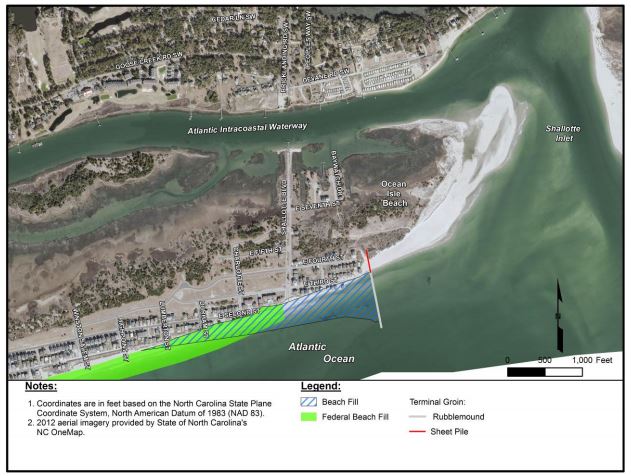
A lawsuit to stop one southern North Carolina beach town’s federally approved terminal groin project will soon be argued in an appellate court.
The National Audubon Society’s case against the U.S. Army Corps of Engineers and Ocean Isle Beach is scheduled to be heard Dec. 8 in the U.S. Court of Appeals for the Fourth Circuit.
Supporter Spotlight
The court’s ruling may bring an end to a fight that began a little more than three years ago when the Southern Environmental Law Center, or SELC, on behalf of Audubon, filed in August 2017 a lawsuit challenging the Corps’ approval of the proposed project.
The lawsuit claims that the Corps approved the multi-million project without fairly considering other alternatives that would be cheaper for the town’s taxpayers, adequately protect vulnerable properties, and maintain wildlife habitat on the east end of the barrier island.
A district court judge in September 2019 dismissed the case.
Less than a month later, National Audubon Society filed an appeal.

Geoff Gisler, senior attorney with the SELC’s Chapel Hill office, said in an email this week that, depending on the appellate court’s ruling, either side could petition the court for a rehearing or request the Supreme Court take the case.
Supporter Spotlight
“Both types of petitions are rarely granted,” he said. “If we win the appeal, the next step would be for the Corps to prepare a new environmental impact statement.”
The Corps approved a permit for the town’s project Feb. 27, 2017.
By that time Ocean Isle Beach had received a Coastal Area Management Act, or CAMA, major permit from the North Carolina Division of Coastal Management for the hardened shoreline erosion control structure.
The project would include construction of a 750-foot terminal groin of large armor rock. About 264,000 cubic yards of sand dredged from Shallotte Inlet would be placed behind the structure.
The SELC is challenging the adequacy of the Corps’ environmental impact statement, or EIS, specifically alleging that the federal agency failed to fairly evaluate project alternatives in the study and secondary effects of the alternatives presented in the study.
The lawsuit also alleges that the Corps-approved alternative selected by the engineering firm hired by the town to complete the EIS is not the least environmentally damaging alternative and that the Corps did not independently evaluate environmental information submitted by Coastal Planning & Engineering of North Carolina, Inc.
“We continue to believe that the Corps failed to uphold its basic obligation to do an objective analysis of options to respond to erosion on the east end,” Gisler said.
The terminal groin, a wall-like structure built perpendicular to the shore, would be designed to mitigate erosion along 3,500 feet of the town’s oceanfront shoreline west of Shallotte Inlet.

For more than two decades, chronic erosion has chewed away at the east end of the island, destroying homes, damaging roads and public beach accesses.
Throughout the years, the town has spent more than $3.5 million in repairs and replacing damaged infrastructure, including relocating water and sewer lines.
A sandbag revetment was installed years ago to curb the erosion.
“So, there’s very much a need for the terminal groin in this area,” said Daisy Ivey, the town’s administrator.
Town officials had hoped to kick off construction of the terminal groin in November of 2017.
At the time, initial construction of the project was estimated to cost around $5.7 million. The 30-year cost of the project was an estimated $45.8 million.
It is unclear whether the proposed project’s estimated cost will be higher now.
“I can’t answer that, but it just depends on how the bids were to come in,” Ivey said.
Audubon officials have argued the proposed terminal groin would be particularly devastating to an undeveloped refuge on the island’s east end, which has long been a haven for boaters, families and wildlife.
It is also one of the few remaining natural inlets available for shorebirds.
In its biological opinion, the U.S. Fish and Wildlife Service determined the project may affect, but not jeopardize, the existence of several endangered species, including the piping plover and loggerhead nesting sea turtles.
The National Marine Fisheries Services concluded that federally designated essential fish habitat, or EFH, is expected to be adversely affected by the proposed project because habitat would be modified in the groin footprint and during dredging.
A special condition of the federal permit prohibits work on the proposed project being done between April 1 through Nov. 15 to protect fish and protected species during seasonal migrations.
That means it’s too late for the town to move forward with construction this year if the court rules in its favor, Ivey said, adding that the town would move forward with the project as soon as possible pending the outcome of the case.







